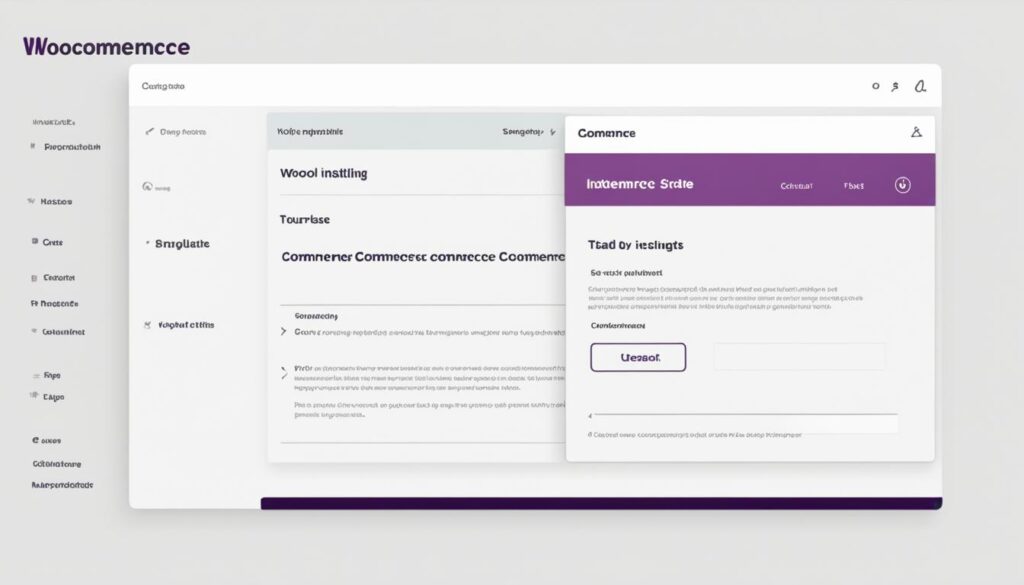Table of Contents
Welcome to our step-by-step guide on building a WordPress ecommerce website. If you’re looking to launch your own online shop, you’ve come to the right place. In this article, we’ll provide you with all the information you need to create a successful online store using the power of WordPress.
WordPress is a popular content management system that allows you to easily create and manage your website. With the right plugins and themes, you can transform your WordPress site into a fully functional ecommerce platform. In this guide, we’ll walk you through the process, ensuring that you have all the tools and knowledge to set up an online shop that meets your specific needs.
- WordPress is a versatile platform that can be used to create an ecommerce website.
- By following our step-by-step guide, you’ll be able to launch your online shop effortlessly.
- Choosing the right WordPress theme is crucial for creating an attractive and functional ecommerce website.
- The WooCommerce plugin is essential for running an ecommerce website on WordPress.
- Designing your online store with user experience and branding in mind will help attract and retain customers.
Choosing the Right WordPress Theme
When it comes to building your ecommerce website on WordPress, choosing the right theme is crucial for the success of your online store. A WordPress theme serves as the foundation of your website, determining its overall appearance, functionality, and user experience.
With countless WordPress themes available in the market, it can be overwhelming to make a decision. However, by considering key factors such as ecommerce features and customization options, you can narrow down your choices and find a theme that aligns with your specific requirements.
Ecommerce Features:
The ideal WordPress theme for your online store should come equipped with a range of ecommerce features that enhance the shopping experience for your customers. Some essential ecommerce features to look for include:
- Product catalogs
- Shopping cart functionality
- Secure payment gateways
- Wishlist and product comparison
- Product reviews and ratings
Customization Options:
While having a theme with built-in ecommerce features is important, customization options are equally crucial. A theme that allows for easy customization enables you to personalize your website’s design and layout according to your brand identity. Look for themes that offer:
- Flexible color schemes
- Customizable headers and footers
- Drag-and-drop page builders
- Multiple layout options
- Integration with popular plugins
Remember, your ecommerce website should visually represent your brand and provide a seamless shopping experience for your customers. By choosing a WordPress theme with ecommerce features and customization options, you can create a visually appealing and highly functional online store.
“A well-designed theme with the right ecommerce features and customization options can set your online store apart from the competition and attract more customers.”
To illustrate the importance of choosing the right WordPress theme, here is a curated comparison table featuring three popular ecommerce themes:
| Theme | Ecommerce Features | Customization Options | Price |
|---|---|---|---|
| Theme A | Product catalogs Shopping cart functionality Secure payment gateways Wishlist and product comparison Product reviews and ratings |
Flexible color schemes Customizable headers and footers Drag-and-drop page builders Multiple layout options Integration with popular plugins |
$99 |
| Theme B | Product catalogs Shopping cart functionality Secure payment gateways Wishlist and product comparison Product reviews and ratings |
Flexible color schemes Customizable headers and footers Drag-and-drop page builders Multiple layout options Integration with popular plugins |
$129 |
| Theme C | Product catalogs Shopping cart functionality Secure payment gateways Wishlist and product comparison Product reviews and ratings |
Flexible color schemes Customizable headers and footers Drag-and-drop page builders Multiple layout options Integration with popular plugins |
$89 |
By comparing the features, customization options, and pricing, you can make an informed decision and select the WordPress theme that best suits your ecommerce website’s needs.
Setting Up WooCommerce Plugin
In this section, we will guide you through the process of setting up the WooCommerce plugin, an essential tool for running an ecommerce website on WordPress. By following the installation and configuration steps below, you’ll be on your way to launching a successful online shop.
Installation
To install the WooCommerce plugin, please follow these simple steps:
- Log in to your WordPress dashboard.
- Navigate to “Plugins” in the left-hand menu and click on “Add New”.
- In the search bar, type “WooCommerce”.
- Locate the WooCommerce plugin and click on the “Install Now” button.
- Once the installation is complete, click on “Activate” to enable the plugin.
Configuration
After successfully installing the WooCommerce plugin, it’s time to configure it for your specific needs. Follow these steps to customize your online shop:
- Go to the WooCommerce settings by clicking on “WooCommerce” in the left-hand menu.
- Under the “General” tab, set your store’s location, currency, and other basic information.
- Next, navigate to the “Products” tab to define your product settings, such as inventory management and display options.
- Click on the “Checkout” tab to configure your payment gateway settings and enable secure transactions.
- Under the “Shipping” tab, set up your shipping methods, rates, and options.
- Take some time to explore the remaining tabs and customize additional settings as needed.
Optimize Your WooCommerce Setup
Optimizing your WooCommerce setup involves fine-tuning various elements of your online shop to enhance its performance and boost sales. Consider implementing the following tips:
- Choose a responsive theme: Select a theme that is compatible with mobile devices, ensuring a seamless shopping experience for users on smartphones and tablets.
- Add product categories: Organize your products into relevant categories to make it easier for customers to navigate and find what they’re looking for.
- Enable product reviews: Encourage customers to leave reviews and ratings for your products, as they can greatly influence purchasing decisions.
- Implement a reliable backup system: Protect your store’s data by regularly backing it up to a secure location.
“Setting up the WooCommerce plugin is the first step towards building a successful ecommerce website. By following the installation and configuration steps provided, you can create a fully functional online shop that meets your specific requirements.”
Now that you have successfully installed and configured the WooCommerce plugin, you are ready to move on to the next section, where we will discuss designing your online store and ensuring an exceptional user experience.

Designing Your Online Store
In today’s digital marketplace, having a well-designed online store is crucial for creating a positive user experience and reinforcing your brand. A visually appealing website that aligns with your branding not only captivates visitors but also builds trust and encourages them to make a purchase. In this section, we will explore the importance of effective store design and user experience, and provide you with practical tips to create an online store that leaves a lasting impression on your customers.
Creating a Visually Appealing Website
When it comes to store design, aesthetics play a significant role in capturing the attention of your audience and enticing them to explore your products. Here are some key elements to consider:
- Colour scheme: Choose a palette that complements your branding and evokes the desired emotions. Consistency in your colour scheme helps create a cohesive and memorable shopping experience.
- Typography: Select fonts that are easy to read and reflect your brand personality. Balance fonts for headers and body text to create a harmonious visual hierarchy.
- Layout: Design your website with a user-friendly interface that enables intuitive navigation. Utilize grids and white space effectively to enhance readability and highlight key elements.
Remember, simplicity is key. Avoid cluttering your website with excessive graphics or information overload. Maintain a clean and organized layout that allows your products to shine.
Optimizing User Experience
In addition to visual appeal, prioritizing user experience is vital for driving conversions and customer satisfaction. Here are some tips to enhance the usability of your online store:
- Intuitive navigation: Ensure that your website’s navigation is easy to understand and navigate, allowing users to find products and relevant information effortlessly.
- Mobile responsiveness: With a significant portion of online shoppers using mobile devices, it’s essential to optimize your website for mobile responsiveness. This ensures a seamless shopping experience across all devices.
- Fast loading speed: Improve loading speed by optimizing images, reducing unnecessary plugins, and leveraging caching techniques. A fast-loading website significantly enhances user experience and reduces bounce rates.
- Streamlined checkout process: Simplify the checkout process by minimizing the number of steps and asking only for necessary information. Offer multiple secure payment options to cater to different customer preferences.
Case Study: Apple’s Online Store
“Design is not just what it looks like and feels like. Design is how it works.” – Steve Jobs
Apple’s online store is a prime example of a well-designed ecommerce website. The sleek and minimalist design reflects the company’s brand image and the overall user experience aligns with their commitment to simplicity and innovation. The strategically placed product images, clear call-to-action buttons, and seamless navigation make it easy for customers to browse, select, and purchase products with ease. Apple’s attention to detail in store design highlights the importance of incorporating user experience at every stage of the design process.
The Impact of Store Design on User Experience and Conversion
| Element | Effect on User Experience | Effect on Conversion |
|---|---|---|
| Visually appealing design | Engages and captivates visitors | Influences purchase decisions |
| Intuitive navigation | Facilitates easy product discovery | Increases completion of desired actions |
| Mobile responsiveness | Provides a seamless shopping experience on various devices | Maximizes reach and accessibility |
| Fast loading speed | Reduces frustration and abandonment | Improves customer satisfaction and loyalty |
| Streamlined checkout process | Simplifies the path to purchase | Minimizes cart abandonment |
By focusing on store design and user experience, you can create an online store that not only attracts customers but also turns them into loyal advocates of your brand. Take inspiration from successful ecommerce websites, like Apple’s online store, and implement design elements and features that align with your brand identity and optimize the shopping journey.
Adding Products and Managing Inventory
When it comes to running a successful ecommerce website, effective product management and inventory tracking are crucial. Ensuring that your products are accurately categorized, adequately stocked, and priced competitively can significantly impact your sales and customer satisfaction.
Product Categorization
Organizing your products into relevant categories makes it easier for customers to navigate your online store and find what they are looking for. Consider creating broad categories and subcategories to provide a logical structure.
“Proper product categorization enhances the shopping experience for your customers, leading to increased conversion rates and customer satisfaction.”
For example, if you’re running a clothing store, you may have categories such as “Men’s Clothing,” “Women’s Clothing,” and “Accessories.” Within each category, you can further divide the products into subcategories based on specific items or brands.
Inventory Tracking
Keeping a close eye on your inventory levels is essential for avoiding stockouts and ensuring timely order fulfillment. Implementing inventory tracking systems and processes is crucial in maintaining accurate stock information.
Consider using inventory management software that integrates with your ecommerce platform to automate inventory updates and provide real-time visibility into stock levels. This allows you to proactively manage inventory, replenish low stock items, and avoid overselling.
Pricing Strategies
Pricing your products competitively can make a significant difference in attracting customers and driving sales. It’s essential to consider your target market, competition, and value proposition when determining the right pricing strategy.
Some common pricing strategies include:
- Cost-based pricing: Calculating the price based on the cost of production and desired profit margin.
- Competitive pricing: Setting prices in line with or slightly below your competitors to attract price-conscious customers.
- Value-based pricing: Pricing products based on the perceived value they offer to customers.
Experimenting with different pricing strategies and monitoring their impact on sales and profitability can help you find the optimal pricing strategy for your ecommerce business.
By effectively managing products and tracking inventory, you can ensure seamless operations and provide a positive shopping experience for your customers.
| Benefits of Effective Product Management and Inventory Tracking |
|---|
| Improved customer experience and satisfaction |
| Prevention of stockouts and overselling |
| Avoidance of overstocking and unnecessary inventory costs |
| Informed decision-making based on accurate inventory data |
| Increased operational efficiency and productivity |
Setting Up Payment Gateways and Managing Orders
In the world of ecommerce, setting up secure and reliable payment gateways is crucial to ensure smooth online transactions. Additionally, efficient order management and excellent customer support are essential for a seamless shopping experience. In this section, we will guide you through the process of setting up payment gateways, managing orders, and providing excellent customer support to enhance your ecommerce operations.
Setting Up Payment Gateways
Payment gateways are the vital bridge between your customers and their financial transactions. By integrating secure and reliable payment gateways into your WordPress ecommerce website, you can offer your customers a variety of payment options and build trust in the checkout process. To set up payment gateways:
- Research and choose a payment gateway provider that fits your business needs. Popular options include PayPal, Stripe, and Worldpay.
- Sign up for an account with your chosen payment gateway provider.
- Configure the plugin provided by the payment gateway provider on your WordPress website. This process may involve adding API keys or other credentials.
- Test the payment gateway to ensure it works seamlessly with your website and processes transactions securely.
Once your payment gateway is set up, customers will be able to make payments using their preferred methods, such as credit cards, digital wallets, or bank transfers. This flexibility can significantly improve your conversion rates and customer satisfaction.
Managing Orders
Efficient order management is key to ensuring smooth fulfillment and timely delivery of your customers’ purchases. By effectively managing and tracking orders, you can streamline your operations and provide accurate updates to your customers. Here are some best practices for managing orders:
- Implement an order management system or use the built-in features of your ecommerce plugin, such as WooCommerce, to track orders from creation to delivery.
- Automate order processing as much as possible to reduce manual errors and save time.
- Regularly update your customers on the status of their orders, providing shipping/tracking information and estimated delivery dates.
- Handle order cancellations and returns promptly, ensuring a smooth refund process for your customers.
Providing Exceptional Customer Support
Excellent customer support is crucial for building loyalty and repeat business. By providing timely and helpful assistance, you can enhance the overall shopping experience and foster positive relationships with your customers. Here are some tips for providing exceptional customer support:
- Offer multiple channels for customers to reach out for support, such as email, live chat, and phone.
- Respond to customer inquiries promptly and professionally, striving for quick resolutions.
- Provide self-help resources, such as FAQs and troubleshooting guides, to empower customers to find solutions on their own.
- Ensure your customer support team is well-trained and equipped to handle customer issues efficiently.
By setting up payment gateways, managing orders effectively, and providing exceptional customer support, you can create a seamless and secure shopping experience for your customers, leading to increased customer satisfaction, sales, and business growth.
Conclusion
In conclusion, building your WordPress ecommerce website can be a seamless process if you follow our step-by-step guide. By carefully selecting the right WordPress theme, setting up the WooCommerce plugin, designing your online store, and effectively managing your products, inventory, and orders, you can create a successful online shop that delivers a great user experience.
Remember, a visually appealing store design aligned with your branding plays a crucial role in attracting customers and keeping them engaged. Ensuring easy navigation and a smooth checkout process with secure payment gateways will help build trust and encourage repeat purchases.
By implementing the strategies and tips discussed in this article, you’ll be well-equipped to establish and grow your online business. So, take the time to plan and execute each step carefully, and you’ll be on your way to achieving ecommerce success with your WordPress website.
FAQ
What is a WordPress ecommerce website?
A WordPress ecommerce website is an online shop built using the WordPress platform. It allows you to sell products or services directly to customers, offering a seamless shopping experience.
Why is choosing the right WordPress theme important for my ecommerce website?
Choosing the right WordPress theme is crucial for your ecommerce website as it determines the overall design and functionality of your online shop. Look for themes that offer ecommerce features, customization options, and are visually appealing.
How do I set up the WooCommerce plugin?
To set up the WooCommerce plugin, you need to install and activate it on your WordPress website. Once activated, follow the configuration steps, including adding products, setting up payment gateways, and managing orders.
Why is store design important for my online shop?
Store design plays a vital role in creating a positive user experience and establishing your brand identity. Pay attention to visual elements, ease of navigation, and overall aesthetics to create an attractive and engaging website.
How can I effectively manage product inventory on my ecommerce website?
Managing product inventory involves categorization, tracking stock levels, and ensuring accurate pricing. Utilize inventory management tools and implement strategies for efficient stock control and seamless order fulfillment.
What are payment gateways and how do I set them up?
Payment gateways are online platforms that enable secure transactions between your customers and your ecommerce website. Popular payment gateways include PayPal, Stripe, and Square. You can set them up by following their integration instructions or using plugins designed for specific gateways.
How can I provide excellent customer support for my online shop?
Excellent customer support is essential for maintaining customer satisfaction. Offer multiple contact channels, timely responses, and resolve any issues promptly. Use communication tools such as email or live chat to address customer inquiries and concerns.
Why is it important to follow the step-by-step guide to build my WordPress ecommerce website?
Following a step-by-step guide helps ensure that you cover all the necessary aspects of building an ecommerce website, avoiding common pitfalls. It provides a structured approach and helps you launch your online shop effortlessly, saving time and effort.












